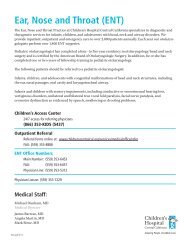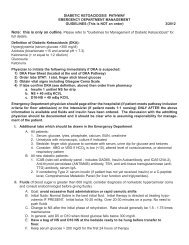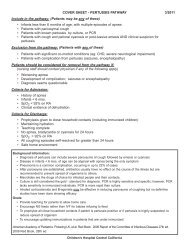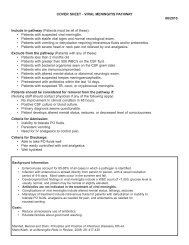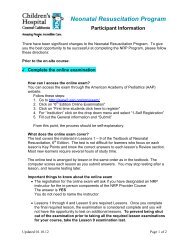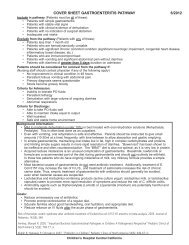Pool Safety Tips - Children's Hospital Central California
Pool Safety Tips - Children's Hospital Central California
Pool Safety Tips - Children's Hospital Central California
Create successful ePaper yourself
Turn your PDF publications into a flip-book with our unique Google optimized e-Paper software.
<strong>Pool</strong> <strong>Safety</strong> <strong>Tips</strong><br />
<br />
Never leave children alone in or near a pool, not even for a moment.<br />
<br />
Whenever infants or toddlers are in or around water, an adult should be within arm’s<br />
length, providing “touch supervision”. Do not consider a child drown proof because<br />
they have had swimming lessons.<br />
<br />
Enclose your pool on all four sides with a fence or barrier that it at least 5 feet tall,<br />
making sure there are no foot or handholds that could help a young child to climb it.<br />
It is best if the house is not one side of the barrier. However, if it is…then doors leading<br />
from the house to the pool should be protected with an alarm that produces an audible<br />
sound when a door is unexpectedly opened. All gate entrances to the pool should be<br />
self-closing and self-latching.<br />
Remember that these barriers are not child proof, but they provide layers of protection<br />
for a child who strays from supervision. Barriers give parents additional time to locate<br />
a child before the unexpected becomes a reality.<br />
<br />
Toys are toys…they should not be thought of as life preservers to keep the child afloat.<br />
Remove toys from in and around the pool when it is not in use.Toys can attract young<br />
children to the pool.<br />
<br />
Be careful with children using “floaties”, “water wings” or “swimmies”. (See the<br />
drawing on the opposite page.) Remember: These are not life preservers…they can give<br />
a false sense of security to the child and parent. Life preservers will have “Approved by<br />
the Coast Guard as a Personal Flotation Device (PFD)” printed on the vest. If it doesn’t<br />
say these words, it is not a PFD.<br />
<br />
During a social event, appoint a “designated watcher” to protect young children from<br />
pool accidents. Adults may take turns being the “watcher”. When adults become<br />
preoccupied, children are at risk. Older siblings should not be asked to watch younger<br />
children in the water. They are neither trained nor mature enough to be given such an<br />
ADULT responsibility.<br />
Learn CPR. Know what to do in an emergency, starting with a call to 9-1-1.<br />
<br />
If a child is missing, check the pool first. Seconds count in preventing death or disability.<br />
Go to the edge of the pool and scan the entire pool, bottom and surface, as well as the<br />
pool area.



